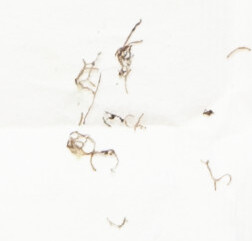
Lepidoziaceae is a family of leafy liverworts. It is a group of small plants that are widely distributed.

Aneuraceae is a family of thallose liverworts in the order Metzgeriales. Most species are very small with narrow, branching thalli.

Frullania is the only genus of liverworts in family Frullaniaceae. It contains the following species:
Colura irrorata is a species of liverworts in family Lejeuneaceae. It is endemic to Ecuador. Its natural habitat is subtropical or tropical moist lowland forests. It is threatened by habitat loss. The species was previously place known as Myriocolea irrorata, but was transferred to Colura in 2012 following a phylogenetic analysis of nuclear and plastid molecular markers and a reinterpretation of morphological characters.
Schistochila vitreocincta is a species of liverwort in the family Schistochilaceae. Under its synonym Perssoniella vitreocincta it was the only species in the monotypic genus Perssoniella and family Perssoniellaceae. It is endemic to New Caledonia. Its natural habitat is subtropical or tropical dry forests.
Lejeunea drehwaldii, synonym Sphaerolejeunea umbilicata, is a species of liverworts in the family Lejeuneaceae. It is endemic to Colombia. Its natural habitat is subtropical or tropical moist lowland forests.

Pleurozia is the only genus of liverworts in the family Pleuroziaceae, which is now classified in its own order Pleuroziales, but was previously included in a broader circumscription of the Jungermanniales. The genus includes twelve species, and as a whole is both physically distinctive and widely distributed.
Acrobolbus epiphytus is a liverwort species in the genus Acrobolbus. It occurs in New Zealand.

Cephaloziaceae is a family of liverworts.

Calypogeiaceae is a family of liverworts. This type of plant is a calcifuge.

Aneura is a genus of liverworts in the family Aneuraceae.

Acrobolbus pseudosaccatus, synonym Tylimanthus pseudosaccatus, is a bryophyte, a species from the liverwort family Acrobolbaceae. The family grows on logs, rocks, and soil. Under certain circumstances, however, they are epiphyte, growing on other plant species.

Lynika Strozier was an American researcher and scientist who died from COVID-19 in June 2020, during the COVID-19 pandemic in Illinois.
Elizabeth Anne Brown was a New Zealand-born Australian bryologist who primarily contributed to the systematics of liverworts.

Lepidolaenaceae is a family of liverworts belonging to the order Porellales.

Frullania wairua, the spirit liverwort or radar bush liverwort, is a species of liverwort in the order Porellales. It is one of 24 species in the large genus Frullania that are native to New Zealand. The species was first described by Matt von Konrat and John E. Braggins in 2005 in the New Zealand Journal of Botany.
John E. Braggins is a New Zealand botanist and bryologist, known for his research into ferns and liverworts. Braggins lectured at the University of Auckland from 1969 until 2000, during which time he supervised and mentored a significant number of New Zealand botanists. During Braggins' career, he has taken part in the identification of 12 species and one suborder, many of which are endemic New Zealand liverworts.

Frullania truncatistyla is a species of liverwort in the order Porellales. The species was first described by Matt von Konrat, Jörn Hentschel, Jochen Heinrichs and John E. Braggins in 2011, and is native to New Zealand.
Frullania colliculosa is a species of liverwort in the order Porellales, native to New Zealand. The species was first described by Matt Von Konrat, Jörn Hentschel, Jochen Heinrichs, John E. Braggins and Tamás Pócs in 2010.
Frullania hodgsoniae is a species of liverwort in the order Porellales, native to New Zealand. The species was first described by Matt Von Konrat, Jörn Hentschel, Jochen Heinrichs, John E. Braggins and Tamás Pócs in 2010.












